Are your paid search and social campaigns generating fake leads?
If so, you’re not alone. According to Gleanster Research only 25% of leads are legitimate and should progress to sales. That leaves three-quarters of your sales pipeline filled with fake and unqualified leads that won’t convert.
Lead gen fraud is a big problem for businesses. Marketing teams that invest heavily in PPC advertising are especially vulnerable, as every single spam lead ultimately reduces your ROAS.
So what can you do about fake leads? In this article, you’ll learn how to elminate lead gen fraud from your sales pipeline, so you can spend your time nurturing genuine leads that eventually turn into closed deals.
What is a fake lead?
Fake leads are generated when a bot fills out your online form, rather than a genuine human. Bots often input stolen user information from real people, making it difficult to tell whether these leads are real or fake.
Fake leads can also include real human visitors giving you false information to avoid giving you their real details. This is usually easier to spot (e.g. johnsmith@fakemail.com), so in this article we’ll primarily focus on the more prevalent form of bot-based lead generation fraud.
Bots are responsible for 38% of fraudulent activity online. It’s the most common source of invalid traffic, so most B2B brands will encounter it:
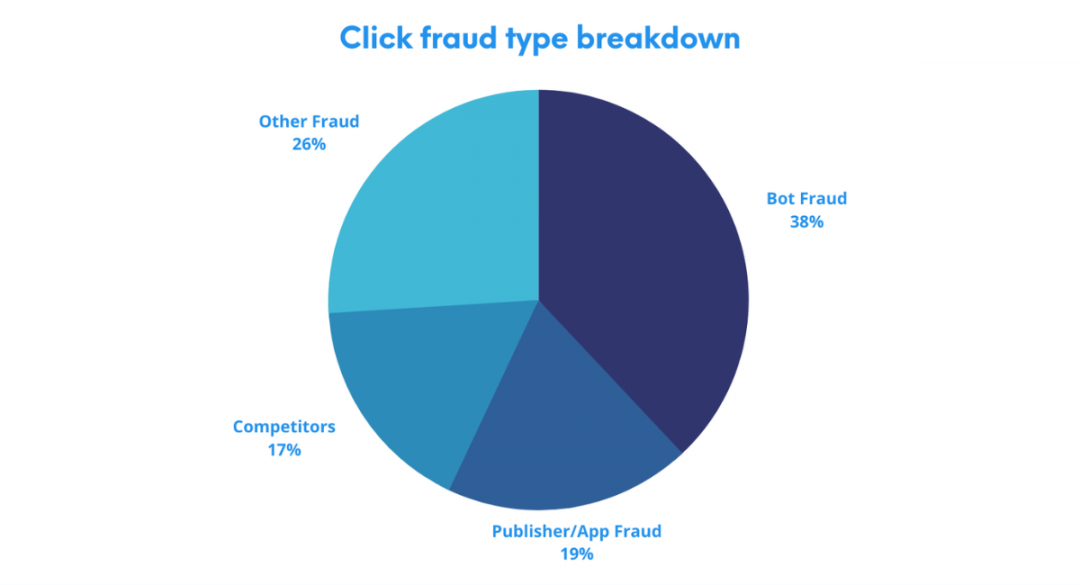
What Is lead gen fraud?
Lead generation fraud is the use of bots to generate fake leads using misappropriated user data. It’s often intended to make money for fraudsters. Other times it can be the result of a deliberate attack from a competitor brand seeking to give themselves an advantage by wasting your PPC budget, but this scenario is much less common.
Bad affiliates may use lead gen fraud to claim more commission by generating leads that don’t offer any value to your company. Some people also create fake leads to use a marketing promotion several times over.
Fake leads often enter the sales funnel via PPC campaigns. By programming bots to not just click your ad but also fill out a form on your site, fraudsters can trick advertisers and ad networks into believing these form submissions are legitimate leads.
This approach is so profitable that some criminals create spoof sites that are visited purely by bots, then sell ad space to legitimate advertisers. This is how the Methbot scheme generated more than $7m in ad fraud profits for the scammers.
While lead fraud can impact all ad types, it’s particularly common on the Google Display Network. Our research shows that 36% of all display network clicks are fraudulent.
How do fake leads affect performance marketers?
Fake leads can have a serious impact on your performance marketing efforts, thanks to:
- Wasted ad spend — Up to a fifth of ad spend is used on clicks from fake users.
- Wasted time — Following up on fake leads wastes a significant amount of time.
- Distorted analytics data — Fake clicks skew your data, leading to poor retargeting accuracy and contaminated automated campaigns.
All of these impacts can cost your business money. Exactly how much you stand to lose depends on several factors, including:
- Fraud scale and sophistication — Large lead generation fraud attacks and sophisticated bots that are harder to detect are more likely to cause serious or sustained losses.
- How soon you detect the source — Well-hidden bot sources which are driving fake leads may take longer to deal with, causing greater losses of time and money over time.
Are fake leads becoming more prevalent?
In short, yes. Thanks to increasing levels of PPC automation and bot sophistication, fake leads are getting more prevalent across search and social platforms like Google Ads and LinkedIn Ads.
These platforms don’t tend to publish their bot numbers, perhaps because knowing the true scale of the problem might drive advertisers away. Acknowledging the extent of the bot problem could also leave platforms open to claims for financial reparations. Kasim Aslam at Solutions 8 says:
"I think Google doesn’t want people to see: ‘Oh, I didn’t realise how much fraudulent traffic was there.’ So they almost have to keep the problem going, because if they solve the problem overnight, it’s an instant recognition of just how bad this was."
Kasim Aslam
Founder, Solutions 8
Fake leads stemming from bot traffic are especially prominent in Performance Max campaigns, primarily because it forces B2B brands to use Google Display ads when they typically would have avoided them in the past. In fact, the problem is so bad that some B2B marketers are actively avoiding PMax:
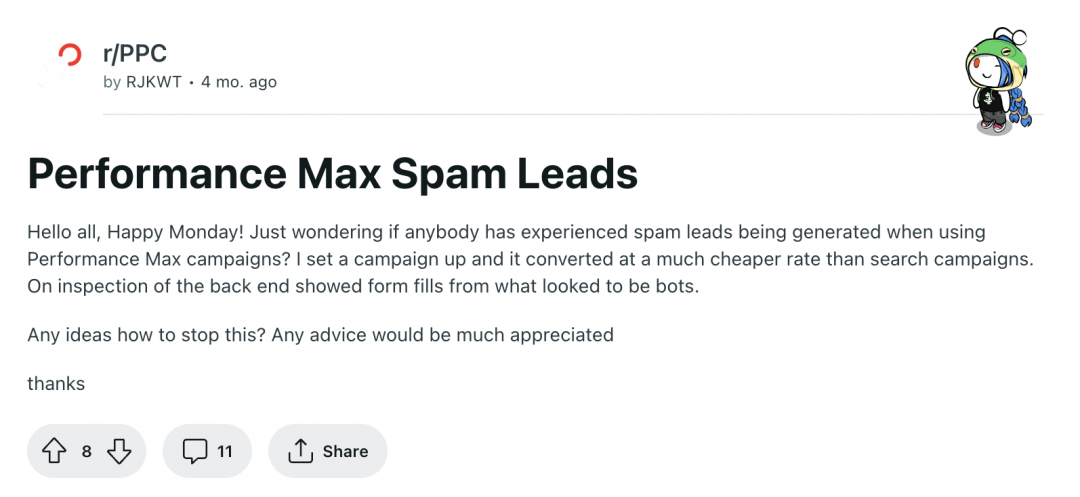

Performance Max removes a lot of control from advertisers. While there are ways to optimise your Performance Max campaigns, you have to trust Google’s algorithms to make the right spending decisions. But with the amount of bot activity affecting the display network in particular, relinquishing control comes with a cost. Kasim explains further:
"We’re finding ways to fight bot traffic, and it’s hard, it’s a pain. And it inhibits our ability to use Performance Max. We’re still having a hard time with PMax for lead gen. Every sales call I do with a lead gen client is like, ‘Well, it can work, here are the problems, change your entire conversion stack.’ I just wish we had more help from Google."
Kasim Aslam
Founder, Solutions 8
Since Google, LinkedIn, and other social platforms aren’t likely to do anything meaningful about fake leads any time soon, what can you do to tackle the problem?
8 common signs of fake leads in your B2B campaigns
Learning to identify fake leads in your B2B campaigns can help you save valuable time. Here are eight ways to detect fake leads in your pipeline.
1. Lead quality and intent
Don’t rely on a form submission as the sole indicator of intent. High quality leads that are ready to be approached by sales have probably spent some time on your site researching your product, looking at case studies, and considering your pricing.
You can use B2B marketing intelligence solutions like Clearbit to monitor website visits that show high intent. If you can correlate previous visits showing signs of intent logged in Clearbit with a recently submitted lead form, it’s a strong indicator they’re ready to purchase.
A lead who has never visited your site before and suddenly fills in your demo request form probably isn’t ready to convert. Sending an initial confirmation email to check if it bounces or remains unopened can help you avoid hours of wasted research and phone calls.
By monitoring and optimising lead quality with lead scoring and a well-optimised sales funnel, you can prioritise hot leads over cold or fake leads. Here are some indicators you can use to categorise leads:
| Positive lead intent | Negative lead intent |
| Filled in multiple lead magnets | No previous activity logged |
| Visited website product pages | Unknown IP address |
| Recent social media engagements | Location outside your target area |
| Signed up for webinars | Emails bounced/unopened |
2. Higher ad spend with no rise in conversions
If your ad spend has jumped by 30%, it’s realistic to expect a similar rise in conversions — assuming your traffic is 100% genuine.
A spike in ad spend without a similar rise in conversions, meanwhile, can indicate unwanted activity in your PPC campaigns.
This works both ways. If you limit your ad spend but continue to see a similar number of leads, you could have a bad affiliate using cookie stuffing techniques to claim commission for leads from other sources. Uber lost two-thirds of their $150m ad spend thanks to fraudulent attribution techniques:
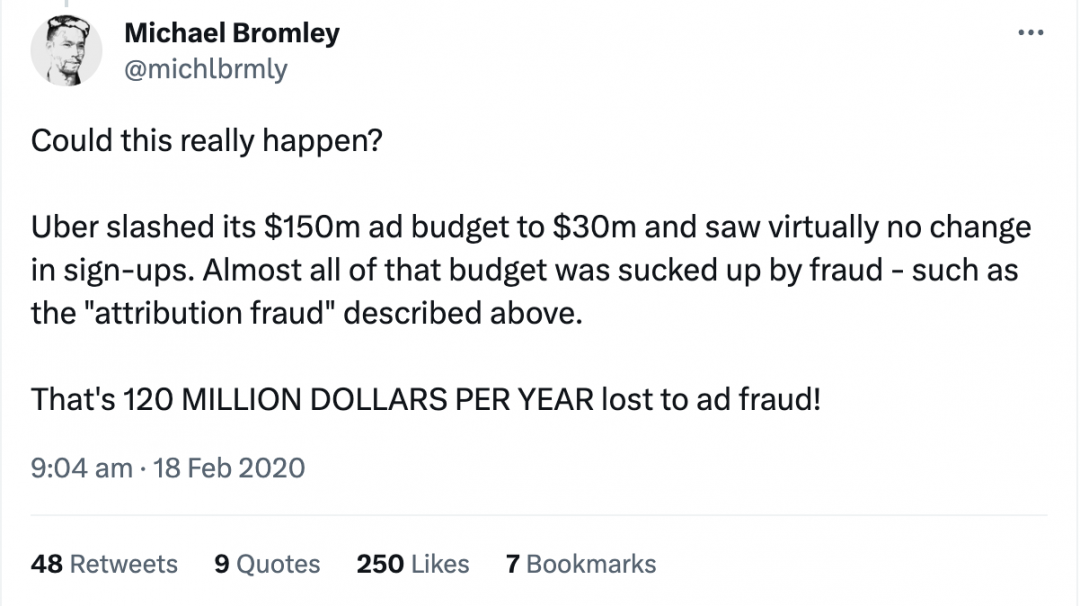
3. Rogue referral URLs
Discover where fake leads come from by checking the referral source of your paid traffic in Google Analytics:
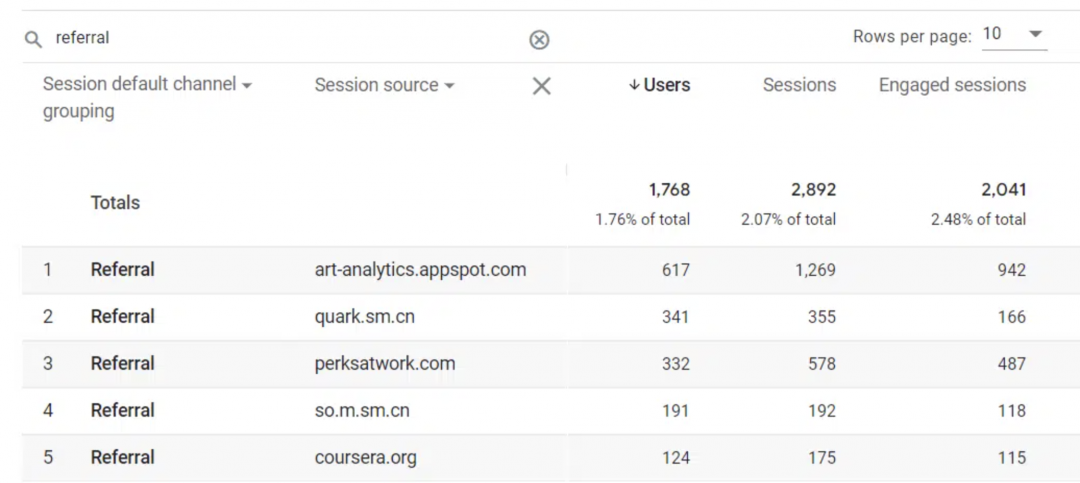
When looking at these URLs, ask yourself:
- Are these the URLs I would expect to see from each site?
- Do I trust these sites to send genuine traffic to my site?
- If any of the sites are unfamiliar, can I find reviews of them?
- What’s the content quality like on the site?
- Am I happy with my ads being shown on this website?
Try not to jump to conclusions. Just because you’re not familiar with a website, it doesn’t automatically make it suspicious. If there are warning signs but you can’t make a call, consider contacting the referrer to get to the bottom of any rogue activity.
4. Duplicate users and IP Addresses
Humans don’t tend to fill in the same form over and over again. So if you spot multiple form completions from the same user or IP address, this should ring alarm bells.
Sophisticated bots can spoof or change IP addresses. In addition, while some bots use the same email address or phone number, they use unique first and last names. So look at all the contact information to make an informed decision.
5. Out-of-geo conversions
Most advertisers set location limits for ad targeting. So it’s wise to treat any form submissions from outside this area with suspicion. Many fraudsters use VPNs and other spoofing tools to hide their real location.
It’s always possible for humans with a genuine interest in your product to travel or use a VPN. Combine location with other indicators to determine whether the lead is fake or genuine.
6. Abnormally low conversion rates
Look for any anomalies in your PPC conversion data. A sudden drop in conversion rate could signal a high number of fake clicks stemming from invalid traffic. If you don’t have a conversion rate benchmark yet, here are the average lead gen conversion rates by industry:
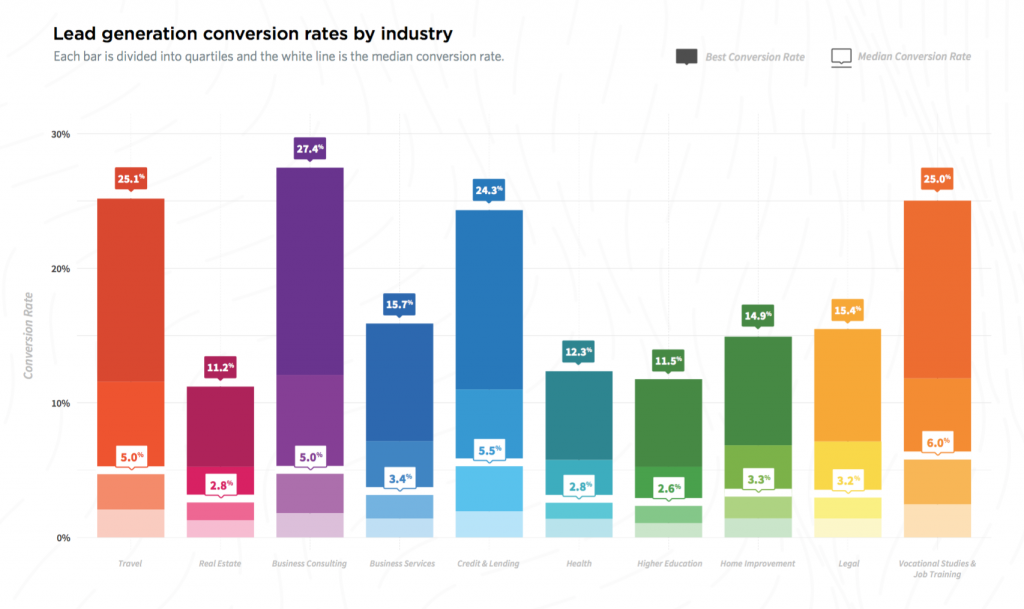
7. Complaints and confusion
Because many fake leads are based on stolen user data, you might follow up with people who are confused or even upset that you have their information.
As well as damaging your reputation, this is dangerous in terms of user privacy. GDPR and other privacy laws require companies to have the right grounds to use personal data to contact people.
Including double opt-in might add friction to your lead generation process, but it can also ensure you have permission to follow up on real leads.
8. Unusual hour conversions
If most of your leads come in nine-to-five, Monday to Friday, it can be disconcerting if you suddenly start getting lots of conversions at night or on the weekends. Sending a quick email to validate their interest may be quicker than putting in hours of research at this early stage.
Conversions at odd hours may be down to bots, but it’s also possible to get a lead from someone in another timezone. Pair this information with other intent signals to determine if the lead is genuine or not.
What you can do to protect against fake leads and lead gen fraud
The indicators above will help you spot fake leads more easily. And while it’s not easy to block fake leads altogether, the tips below can help you protect your pipeline from lead gen fraud.
Before we go into more detail on the measures to stop fake leads, it's worth taking a look at PPC expert Scott Carruther's episode of the Paid Media Lab podcast for a more in-depth discussion on lead gen optimization as a whole, and how moving to a value-driven approach can increase efficiency while lowering the impact of lead gen fraud:
Now, let's talk about the actions you can take now to actively reduce lead gen fraud:
Screen your affiliates and partner agencies
Affiliates are a significant contributor to lead gen fraud, so you might need to screen potential affiliates more carefully before they sign up. If possible find out:
- Their track record of results — See if other brands have had success working with this affiliate or agency.
- Who their other clients are — See if they’re trusted or used by companies you’re familiar with.
- What their social media engagement is like — Lots of followers but low engagement can indicate bot followers.
- Where they place their ads — Decide if you’re comfortable displaying ads for your brand on these sites.
- How long they’ve been in business — Brand new affiliates may be more likely to use bots to help them get off the ground.
Reputable affiliates should be open with you about their success rates. If they’re cagey or reluctant to share this information, it may be a red flag.
See where fake leads come from
Tracing your fake leads back to the source can help you discover which affiliates or agencies are using dodgy tactics. An affiliate tracking system like Tapfiliate can link leads to their sources.
You can also find out how many fake leads are coming in via your PPC campaigns by using Google Analytics or another marketing attribution tool.
When you know where your fake leads are coming from, you can take steps to protect these entrance points.
Look at your marketing and ad metrics
Review your Google Analytics and Google Ads data regularly to become familiar with normal data patterns, making it easier to spot unusual activity. The following metrics are especially helpful for finding fake leads:
- Number of leads generated
- Lead to customer conversions
- Conversion rate
- Ad spend
Combine these metrics to detect fake leads early. Seeing more leads without an increase in customer conversions could indicate false form fills. You might have a high volume of invalid traffic if your ad spend increases without generating more valuable leads.
All these manual solutions require constant human oversight to keep fake leads in check. Relying on them passes the buck from sales to marketing, without actually solving the problem.
It’s far more efficient to automatically remove fake traffic from your campaigns altogether. That’s where Lunio comes in.
Stop fake leads at the source with Lunio
Instead of relying on manual fake lead detection methods, Lunio’s ad fraud solution removes invalid traffic from your campaigns, cutting off the fake lead supply at the source.
B2B brand Canto achieved a $350,000 increase in qualified pipeline in first two months after adding Lunio’s protection to their paid search campaigns. Previously they were experiencing high volumes of fake demo sign-ups at the same time each month.
The volume of invalid traffic coming through Canto’s campaigns was costing the business $67,400 in ad spend per month. In addition the bad traffic was contaminating analytics and making it hard to accurately report on performance and forecast revenue growth.
By removing this invalid traffic, Canto saw a huge change in their overall ROAS. Their Head of Marketing, Mandee Richards, said:
"Since making the changes Lunio recommended, the issues we were having with lead quality have improved massively. We generated more qualified pipeline in the two months after switching on traffic protection than we had done in the previous two years."
Mandee Richards
Head of Marketing, Canto
Lunio is designed to eliminate invalid traffic across all performance marketing channels. So whether you want to stop fake leads, get more from your LinkedIn ad budget, or use Performance Max without losing control of your ad spend, Lunio can help.



